Role Priest Nationality Spanish | Occupation Priest Name Pedro Arrupe | |
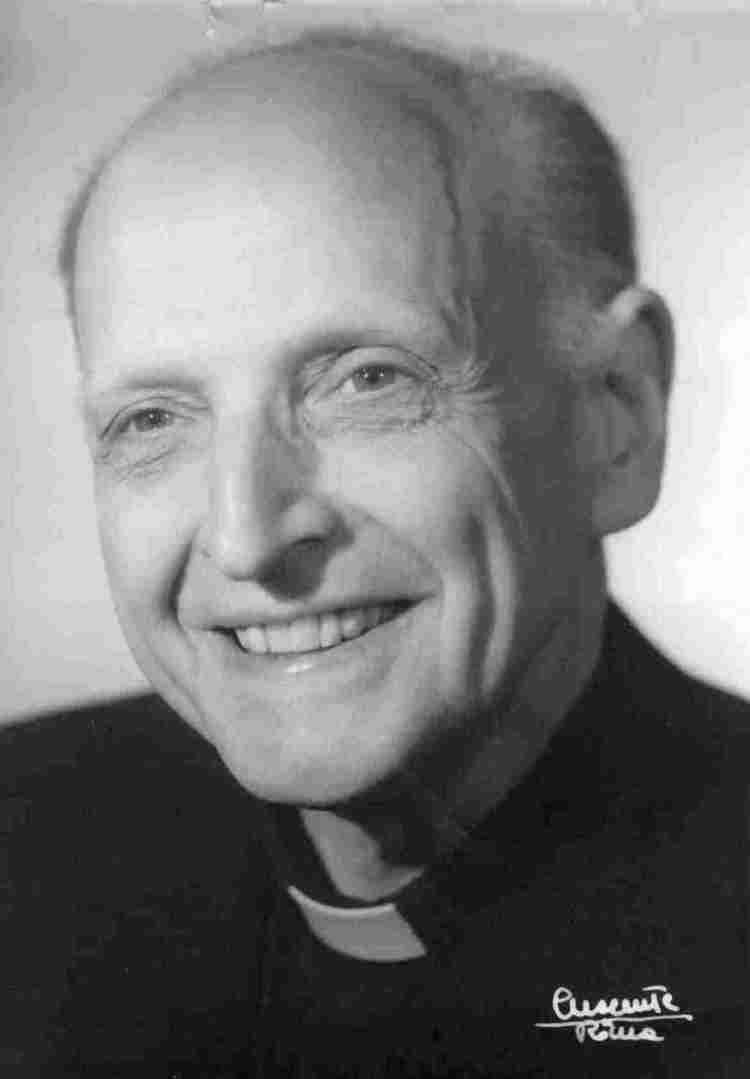 | ||
Full Name Pedro de Arrupe y Gondra Resting place Church of the Gesu, Rome Died February 5, 1991, Rome, Italy Parents Dolores Gondra, Marcelino Arrupe Books Other apostolates today, Justice with Faith Today, Chosen by God: Pedro Arrupe's Retreat Notes, 1965 | ||
Pedro arrupe 1 of 5
Pedro Arrupe, , (14 November 1907 – 5 February 1991) was a Spanish, Basque Jesuit priest who served as the twenty-eighth Superior General of the Society of Jesus (1965–83). Stationed as novice master outside Hiroshima in 1946, he used his medical background as a first responder to the atomic bombing of Hiroshima. He led the Jesuits in the implementation of the Second Vatican Council, especially with regard to a faith that does justice and preferential option for the poor.
Contents
- Pedro arrupe 1 of 5
- Pedro arrupe 2 of 5
- Education and training
- Japan Hiroshima
- Superior General
- Faith and justice
- A cause worth dying for
- Jesuit Refugee Service
- Later life illness and stroke
- Death and burial
- Memorials
- References
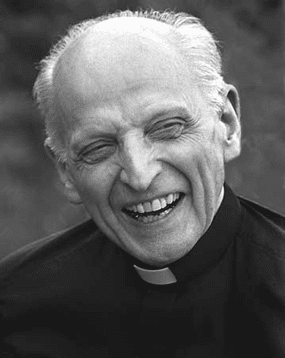
Pedro arrupe 2 of 5
Education and training
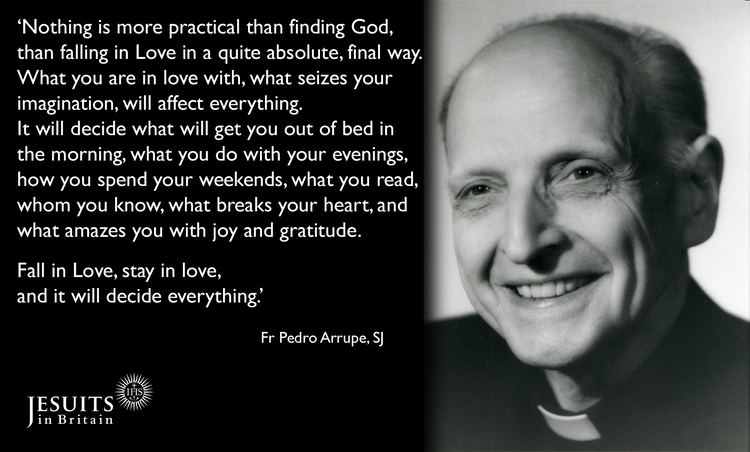
Pedro Arrupe attended school at the Santiago Apostol High School in Bilbao. Later he moved to Madrid to attend the Medical School of the Universidad Complutense. There he met Severo Ochoa, who later won the Nobel Prize in Medicine. One of his teachers was Juan Negrín, a pioneer in physiology, who would become Prime Minister of the Spanish Republic during the Civil War (1936–1939). Arrupe received the top prize in the first year anatomy course.
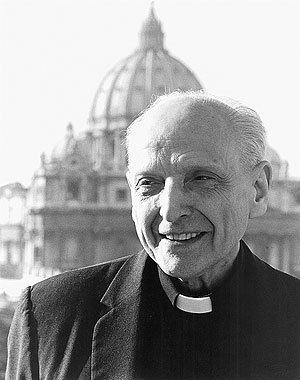
After some years of medical training, Pedro Arrupe joined the Jesuits in 1927 but was unable to pursue his studies for the priesthood in Spain, since the Order had been expelled by the Spanish Republican government (1931-1939). Accordingly, the young Arrupe did his studies in the Netherlands and Belgium before being ordained in 1936. Following his ordination to the priesthood, Arrupe was sent to the United States where he completed a doctorate in Medical Ethics.
Japan - Hiroshima
After his doctorate, Arrupe was sent to work as a missionary in Japan. His early years as missionary were very frustrating for him. No matter what he did, what he organised, people did not attend, and few if any converted to Christianity. When the attack on Pearl Harbor occurred in Hawaii on 7 December 1941, it was 8 December in Japan. Arrupe was celebrating the Eucharist for the Solemnity of the Immaculate Conception when he was arrested and imprisoned for a time, being suspected of espionage. On Christmas Eve, Arrupe heard people gathering outside his cell door and presumed that the time for him to be executed had arrived. However, to his utter surprise, he discovered that some fellow Catholics, ignoring all danger, had come to sing him Christmas carols. Upon this realization, Arrupe recalled that he burst into tears. His attitude of profound prayer and his lack of offensive behaviour gained him the respect of his jailers and judges, and he was set free within a month.

Arrupe was appointed Jesuit superior and novice master in Japan in 1942, and was living in suburban Hiroshima when the atomic bomb fell in August 1945. He was one of 8 Jesuits who were within the blast zone of the bomb, and all 8 survived the destruction. Arrupe described that event as "a permanent experience outside of history, engraved on my memory." Father Arrupe used his medical skills to help those who were wounded or dying. The Jesuit novitiate was converted into a makeshift hospital where between 150 and 200 people received care. Arrupe recalled, "The chapel, half destroyed, was overflowing with the wounded, who were lying on the floor very near to one another, suffering terribly, twisted with pain." In 1958, Arrupe was appointed the first Jesuit provincial for Japan, a position he held until being elected Father General in 1965.
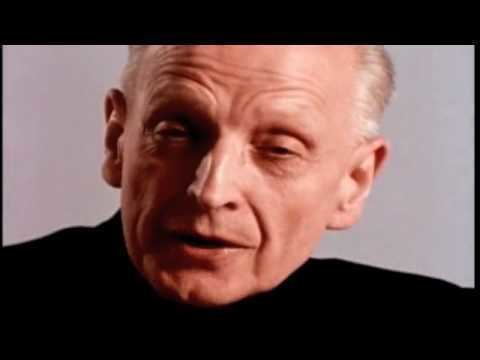
Prior to being elected Father General, Arrupe made a visit to Latin America and, on one occasion, was celebrating the Eucharist in a suburban slum. He was deeply moved at the devotion and respect the people had for Christ in the midst of their abject poverty. After the service, a man invited Arrupe to his hovel, where he told him that he was so grateful for his visit and that he wanted to share the only gift he had, that of watching the setting sun together. Arrupe reflected, "He gave me his hand. As I was leaving, I thought: 'I have met very few hearts that are so kind.'"
Superior General
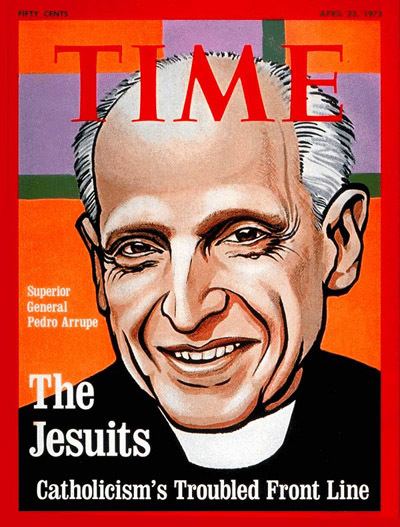
At the thirty-first General Congregation of the Society of Jesus in 1965, Arrupe was elected twenty-eighth Superior General of the Jesuits, and served in that post until 1983. He was only the second Basque to be Father General, the first being the founder Saint Ignatius of Loyola himself. Jesuit Vincent O'Keefe, a friend and advisor to Arrupe, said Arrupe was "a second Ignatius of Loyola, a refounder of the Society in the light of Vatican II." At his election Moscow radio spoke of an unusual man who would bring the Society of Jesus to its powers of the past.
After the changes following Vatican II (1962–1965), there was tension within the Society as to how the life of a Jesuit was to be lived. While some religious groups in the Catholic church have limits on the works they take on, the Society of Jesus encourages its members to follow their interest and talents and the needs of the times into a whole range of ministries – as theologians, missionaries, retreat directors, teachers, artists, writers, musicians, counselors, scientists, and pastors – to bring glory to God in all areas of human endeavor. This is in line with the crowning contemplation of Ignatius' Spiritual Exercises through which Jesuits learn to find God in all things (#236). As Arrupe's biographer said of him, he "saw the hand of God in everything."
Arrupe warned of repeating the answers of yesterday for tomorrow's problems, saying: "If we speak a language no longer appropriate to the hearts of people, we speak only to ourselves because no one will listen to us or try to understand what we say." Arrupe was "hailed as a prophet of our time," not unlike Jesuit Pope Francis who was in theological studies, learning, when Arrupe became Superior General and began speaking his "prophetic" words. The Union of Superior Generals of religious, seeing Arrupe as the right man for our time, elected him five times as their president.
Faith and justice
At the thirty-second General Congregation which convened in 1975, Arrupe's dream of working for the poor was crystallised in the document "Our Mission Today: the Service of Faith and the Promotion of Justice." It stated: "Our faith in Jesus Christ and our mission to proclaim the Gospel demand of us a commitment to promote justice and enter into solidarity with the voiceless and the powerless." Thus, the decree basically defined all the work of the Jesuits as having an essential focus on the promotion of social justice as well as the Catholic faith. Arrupe was keenly aware that in the political climate of the 1970s, the Jesuits’ commitment to working for social justice would bring great hardship and suffering, particularly in those Latin American countries ruled by military juntas.
In a speech to European educators Arrupe made it clear where he stood on matters of faith and justice, saying: "I take very seriously the words of Gandhi, 'I love Christ but I despise Christians because they do not live as Christ lived.' Without a doubt Christian love of neighbor entails a duty to care for the wounds of those that have fallen victim to robbers and are left bleeding by the wayside." In the late 1960s and into the 1980s some theologians in Latin America became increasingly involved in the political sphere, adopting Marxist rhetoric. Many Jesuits were at the forefront of the movement which was called liberation theology and concentrated on seeing Christ as the liberator not only from sin but from all forms of oppression. In its extreme manifestations, liberation theology seemed to subordinate the message of the Gospel to political revolution, with a wholesale acceptance of Marxism. But Arrupe's strong support for relieving the burden of the poor in Latin America enables one to see his "cautionary statements about liberation theology,... as efforts to impose self-discipline to fend off more severe sanctions from outside the order."
A cause worth dying for
On 20 June 1977 the White Warriors Union death squad threatened to kill all 47 Jesuits serving in El Salvador unless they abandoned their work with the poor and left the country within a month. After consulting with the Jesuit community in El Salvador, Arrupe replied "They may end up as martyrs, but my priests are not going to leave because they are with the people." A few months earlier, Jesuit Father Rutilio Grande, a proponent of liberation theology, was assassinated in El Salvador. On 16 November 1989, six Jesuits (Ignacio Ellacuría, Armando Lopez, Joaquin Lopez y Lopez, Ignacio Martín-Baró, Segundo Montes and Juan Ramon Moreno, along with their housekeeper (Julia Elba Ramos) and her daughter (Celina), would be murdered at the Jesuit University of Central America. Others also suffered martyrdom: the chief bishop in El Salvador Archbishop Óscar Romero (though conservative in respect to religion) was gunned down whilst celebrating the Eucharist on 24 March 1980. Lay missionary Jean Donovan, Ursuline sister Dorothy Kazel and Maryknoll sisters Maura Clarke and Ita Ford were beaten, raped and murdered by non-uniformed members of the Salvadoran National Guard on 2 December 1980. They joined some 75,000 Salvadorans who were killed during this troubled period. All the while, Arrupe continued to support and pray for those people who were willing to lay down their lives to help the poor initiate change.
Jesuit Refugee Service
Touched by the plight of the "Vietnamese boat people" in 1979, Pedro Arrupe sent cable messages to some 20 Jesuit major superiors throughout the world sharing his distress at the suffering of these people. He asked them what they could do to help bring relief to refugees and displaced persons in their own regions. He received a positive response, with numerous offers of personnel, medicine, and funding. The next year in 1980 Arrupe founded the Jesuit Refugee Service to coordinate the Society's refugee work. In a speech launching the service he said "Saint Ignatius called us to go anywhere where we are most needed for the greater glory of God. The spiritual as well as the material need of more than 16 million refugees throughout the world today could scarcely be greater. God is calling us through these helpless people." In 2017 JRS listed 47 countries where its 10 regional offices were currently serving nearly 950,000 individuals. Over the years JRS had served an estimated 40 million refugees.
Later life, illness and stroke
On 7 August 1981, after a long and tiring trip throughout the Far East, Arrupe suffered a stroke just after his aeroplane landed at Rome's Fiumicino Airport. He was paralysed on his right side and was able to speak only a few words. This ability gradually deteriorated until he was completely mute. From that time on he lived in the infirmary at the Jesuit headquarters in Rome. He was the first Jesuit Superior-General to resign instead of remaining in office until his death. Pope John Paul II appointed Paolo Dezza as his personal delegate and interim Father General of the Society, passing over Arrupe's own choice (his vicar general). There was a wave of resentment in the Society as this was seen as unwarranted papal interference in Jesuit affairs. For his part, Arrupe never expressed any disagreement or resentment. In 1983, Dezza called the thirty-third General Congregation to deal with the resignation of Arrupe and the election of a successor. Arrupe's resignation was accepted on 3 September 1983 during the Congregation and it proceeded to elect Peter Hans Kolvenbach as Father General. During the opening Session of the Congregation, Arrupe was wheeled into the hall, and a prayer which he had written was read aloud:
More than ever I find myself in the hands of God. This is what I have wanted all my life from my youth. But now there is a difference; the initiative is entirely with God. It is indeed a profound spiritual experience to know and feel myself so totally in God's hands.
During his ten years in the infirmary, praying for and with the Society, Arrupe received many and frequent well-wishers, including Pope John Paul II. Arrupe had earlier expressed what some regard as the key to his life: "Nowadays the world does not need words but lives that cannot be explained expect through faith and love for Christ's poor."
Death and burial
Arrupe died on 5 February 1991. His funeral was held in the Church of the Gesu, Rome, and was attended by crowds that filled the piazza outside the church. Also in attendance were 10 cardinals, 20 bishops, Giulio Andreotti the Prime Minister of Italy, as well as other religious and civil dignitaries. His body, first interred in the Jesuit mausoleum at Campo Verano, was brought back into the Church of the Gesù where it lies in a side chapel.
Memorials
Numerous buildings, schools and Jesuit communities have been named after Pedro Arrupe. They include:
